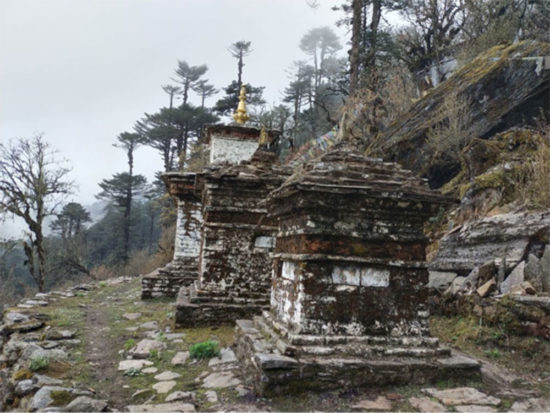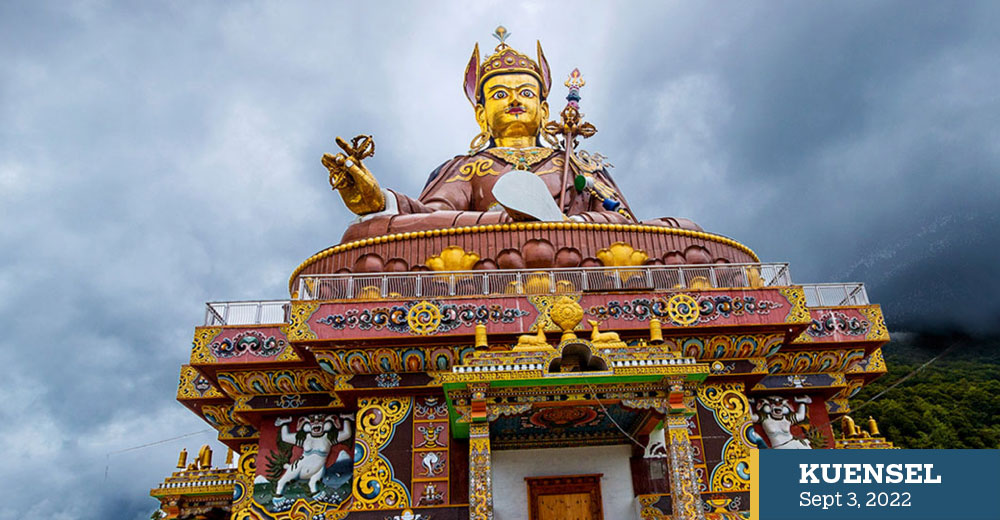Most places in Lhuentse are associated with the revered spiritual pioneers of Buddhism like Guru Rinpoche and Terton Pema Lingpa
Guru Nangsey Zilneon Statue
The magnificent Guru Rinpoche (Guru Nangsey Zilneon) Statue in Lhuentse is said to be one of the world’s tallest statues. Located at Takila, the statue is about 157 feet tall and perches atop a 38-foot lotus. To see the statue, one has to travel over 13 kilometers away from Tangmachu Village. The statue is revered as the fulfillment of a prophecy made by treasure hunter Lerab Lingpa (1856–1926) and well-known yogi Sonam Zangpo that Bhutan will require the physical structure of Guru Padmasambhava to preserve peace and prosperity. To fulfill the prophecy, the Druk Odiyana Foundation led by Khenpo Karpo built the world’s largest Guru statue in Takila. Other spiritual sites near Takila are Karney Goenpa, Barkha Lhakhang, and Rawabi Lhakhang.
Khawchung and Kidlung
On the way to Kurtoed Gewog, there is a well-known Khawchung Lhakhang, located above Zhamling village. It is believed Terton Pema Lingpa prophesied and instructed his son Khedrup Kinga Wangpo to establish his seat in the hamlet, which is located opposite of Khenpajong where a ridge resembling the trunk of an elephant is being hung. As instructed by his father, Kinga Wangpo traveled from Bumthang to Zhamling and constructed a temple in the 14th century, from where the Khowchung Chhoje lineage emerged. The stone bathtub and footprint of a horse can still be seen there. The main relic present in the temple is the Guru Rinpoche statue discovered by Terton Pema Lingpa and later gifted to his son.
While one travels to Kurtoed Dungkar, you spectate another sacred site at hilltop Kidlung, overlooking the Khurichu river. The local people here believed that Kidlung Lhakhang once hold a Tshepamey statue (longevity) discovered by a fisherman. The caretaker narrates that despite the statue having been put in the iron chain mall, it flew three times from there. The three holes on the iron chain mall are still visible to the visitors. Today, the escaped statue is housed in Lhuentse Dzong and it is the main relic.
Kamphu Ney and Nyag Lhakhang
As one travels from Dungkar to Jasabi village, there is cave Lhakhang near the river known as Khamphu Ney. It is one of five Phu (meditation caves) associated with the visit of Guru Rinpoche. Local people believed that Guru Rinpoche blessed the site and hidden many sacred relics underneath the rock. Among many sacred spots and objects, the stupa blessed by Terton Pema Lingpa is one prominent.
Nyag Lhakhang is another place blessed by Terton Pema Lingpa along with Khamphu. It is located 5 hour’s walk from Jasabi village. The main relics of the Lhakhang are the Buddha statue and stupa built by Terton Pema Lingpa.
Yamalung Lhakhang
It is located far from the settlement on the top of a ridge overlooking the valley of Ungar village, Maedtsho Gewog. It is believed of having a similar amount of blessing to visiting the Yamalung monastery in Tibet where Guru Rinpoche meditated and achieved immortality. The Lhakhang houses a statue of Guru Rinpoche as the main relic and it is surrounded by significant spots.
Ruins of Bangtsho Gyalpoi Phodrang
According to oral history, during the 8th century, there came a king from Tibet who was neither human nor animal so-called Khikha Rathoe, later he was known as Bangtsho Gyalpo after he settled in Bangtsho village. He was here because he was exiled from his own country by the Tibetan king. During that moment he brought all his belongings and properties along with him. When he reach Bangtsho, he built his palace under the ground to protect it from Tibetan attack and settled there.
According to the local people, there are nine stories underneath the ground, on contrary, some say there are nine compartments. Today we see seven doors from the top. While constructing the palace, it is said that the king brought stones from the place called Dongchen under Tshochen village with the help of a mule and horses. Today we see the leftover stones at the quarry site. After the completion of the palace, he constructed the tunnel till Khepachu which is underneath the ground for drinking water. The water was also transported with the help of mules and horses. Today, Khepachu lies between Wambur and Umling village. One can still see the sacred words ‘Om Ma Ni Pad Med Hum’ written on a slate that hid the exit doorway of the king’s palace.
Stone Mortars
Stone mortars that appear to have been carved hundreds of years ago are all over a location in Minjey village. According to the locals, the number is approximately 108, which is a lucky number in Buddhism. The inhabitants have no idea who carved them or why. Though some say that the stone mortars date back to the ninth century when Khandro Yeshey Tshogyal used them to prepare Tshog (ceremonial meal) offerings for Guru Padmasambhava or it may perhaps be older.

Phuningla- Aja trails
Phunyingla is located on the mountaintop southeast of Lhuentse Dzong under Tsaenkhar Gewog. It is also a sacred place blessed by Guru Rinpoche. From Phuningla it takes one day to reach Aja Nye one of the sacred places also blessed by Guru Rinpoche. It is considered as one which is exactly located in the center of other mountains; thus, the mountain is known to be Phuningla-the center of the mountains.
Ruins of Khenpajong house
Baeyul Khenpa Jong also referred to as the “Hidden Paradise” of Khenpa Jong, is located in northern Lhuentse. Legends has it that King Trisong Detsen’s demonic son Khikha Rathoed was exiled from Tibet in the seventh century. He made a pledge to destroy Buddhism, and Khenpa Jong came to be the ruler of his awful realm. Guru Padmasambhava chased him covertly to Khenpa Jong, where he addressed the king while pretending to be one Haranagpo. The King agreed to Haranagpo’s plan to jointly overturn Tibet’s governing elite after being astounded by his magical abilities. The Guru flew the king from Khenpa Jong into an unknown region in a flying wooden object using cunning and divine talents. He kept Khenpa Jong hidden so that the king would never discover it again. After being rediscovered by Terton Pema Lingpa in the fifteenth century, Khenpa Jong rose to prominence as a sacred location in the Himalayan Buddhist tradition. From 1939 through 1961, Lama Sonam Zangpo resided at Khenpa Jong. It was a neighborhood of roughly 62 homes, all of which were devoted to religion. However, due to the tensions brought up by the Sino-Indian war of 1962, the settlement was completely abandoned.
Namdroling Goenzin Dratshang
Nam-droling Goenzin Dratshang is built at the sacred location of Guru Drakmar and is situated in Autsho, Tsaenkhar gewog, which is regarded as the entrance to Lhuentse Dzongkhag. The Dratshang’s construction started in 2002 and took almost two decades to finish. His Holiness Trulku Jigme Choeda, the 70th Je Khenpo, blessed it. The monastery is the home to a Chenrezig Ri-Nga Thongdrel, among many other holy artifacts. The 35-foot tall appliqué is the nation’s first of its sort. Each year in January, a week-long Guru Drakmar Drupchen is celebrated. There are numerous monks and instructors at the Dratshang. As one goes few kilometers up from Namdroling Goenzin Dratshang, there stand a magnificent Dragmar Lhakhang attached to the hill.
Lhuentse is one of the most visited districts in the country by domestic tourists because of the district’s rich spiritual significance.
Contributed by
Tshewang Zangmo,
Asst. EDO, Lhuentse


